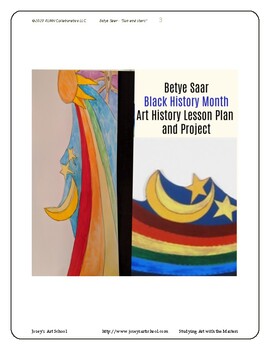
Born in Los Angeles, Saar moved with her family to Pasadena in the early 1930s, shortly before the death of her father in 1931. Pasadena provided a rich cultural and artistic foundation, and she actively took part in arts and crafts classes that allowed her to experiment with a variety of approaches to making objects. Initially a design student at Pasadena City College, Saar transferred to the University of California, Los Angeles, to study interior design. After graduating in 1949, she built an arts community with two recent Los Angeles transplants, jewelry designer Curtis Tann and artist William Pajaud. Later Saar and Tann founded an enamel business, Brown and Tann, that was featured in Ebony magazine in October 1951.
After taking postgraduate courses in printmaking, Saar began creating color etchings, ink drawings, and intaglio prints that shifted her practice away from design into fine art. From these early stand-alone pieces, she began combining her prints with other objects, such as found photographs, or placing them in window frames. Her experiments throughout the 1960s led to her embrace of assemblage, a medium that allowed her to make densely layered works with an equally complex variety of autobiographical and political undertones. Like many of her generation, Saar was deeply affected by the Watts rebellion in 1965 and the death of Martin Luther King Jr. in 1968. In Black Girl's Window (1969), a significant marker of this moment, Saar uses the window as a formal device to explore the effects of race both personally and conceptually. Cosmological elements (stars, the sun, a crescent moon) and pictorial emblems (a skeleton and a roaring lion, among others) in Black Girl's Window also reflect Saar's turn toward mystical iconography, which she describes as a pursuit of “occult atmosphere” in her work.

After seeing Joseph Cornell's retrospective at the Pasadena Art Museum in 1967, Saar too began to encase her objects in boxes and containers that further demarcate their symbolic use. Likened to ritual, Saar's process, and the resulting work, became associated with spiritual practices, particularly those of Africa, Haiti, and Mexico. Though Saar did not travel to Africa until 1977, she and fellow artist David Hammons saw African art at the Field Museum in 1970 while in Chicago for the National Conference of Artists. The connection to other cultures deepened her interest in finding links to a shared universality that could be transmitted by the charge of gathered objects.

Some of these objects were gathered by the artist during trips throughout the world, including Europe, Mexico, and Haiti, or at swap meets and flea markets in Los Angeles. At the latter, Saar collected appalling Americana—negative images of African Americans that she would later reuse in her assemblages. Other objects were personal. As a child she was enchanted with her aunt Hattie Parson Keys's trove of family documents, including photographs. After her aunt's death in 1974, Saar inherited these items and transformed them into assemblages, including Record for Hattie (1975), in which an open case reveals a compartmentalized reliquary of photographs, jewelry, and small tufts of fabric used for quilting. Like much of Saar's work from the decade, memory, nostalgia, and history are conflated with her own personal and familial objects.
SOURCE: CLICK HERE

“To me the trick is to seduce the viewer.
If you can get the viewer to look at a
work of art, then you might be able
to give them some sort of message.”
-Betye Saar
After the assassination of Dr. Martin Luther King Jr., her mystical assemblages became increasingly radical. Saar has since repurposed washboards, jewelry boxes, and racist ephemera as a way of reclaiming images and artistic power. For her best-known work, The Liberation of Aunt Jemima (1972), Saar arms a Mammy caricature with a rifle and a hand grenade, rendering her as a warrior against not only the physical violence imposed on black Americans, but also the violence of derogatory stereotypes and imagery.
SOURCE: CLICK HERE

